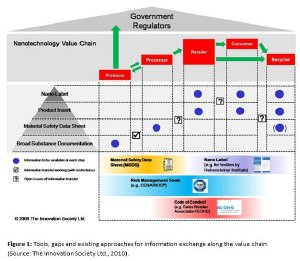Jan 7 2010
Consumers want to know what they buy, retailers have to know what they sell and processors and recyclers need to know what they handle. This applies to ordinary materials but also to products which contain engineered nanomaterials.

However, the relevant nanospecific information is often lost somewhere along the value chain. Following vivid discussions during the NanoRegulation Conference, the Innovation Society (St.Gallen) proposes the model of a "Nano Information Pyramid" in order to debate the challenges and responsibilities of data and information exchange along the value chain. The model can help to address and analyse the critical parts in the value chain.
The big future challenges for the industry, insurances, regulators and authorities will be
- to find appropriate and trustworthy tools to transfer nanospecific data and information along the value chain and to satisfy consumer needs,
- to ensure that the information flow (up and downstream) is not interrupted,
- to allocate costs and responsibilities to the accountable stakeholders.
We hereby suggest a “Nano Information Pyramid” which provides an information exchange framework to illustrate the recipient-specific information transfer along the value chain. The Pyramid (left side of the figure) combines different information transfer tools in with the different levels of the value chain (right side of the figure). This is to ensure that nanospecific (and, if necessary, safety relevant) data are transferred in an appropriate form along the value chain. At the critical positions (?) proper information exchange can be guaranteed by implementation of accurate measures like for example Risk Management Systems (RMS) or Material Safety Data Sheets (MSDS).
You can download a detailed and well illustrated documentation of the “Nano Information Pyramid” under the following link: Nano Information Pyramid